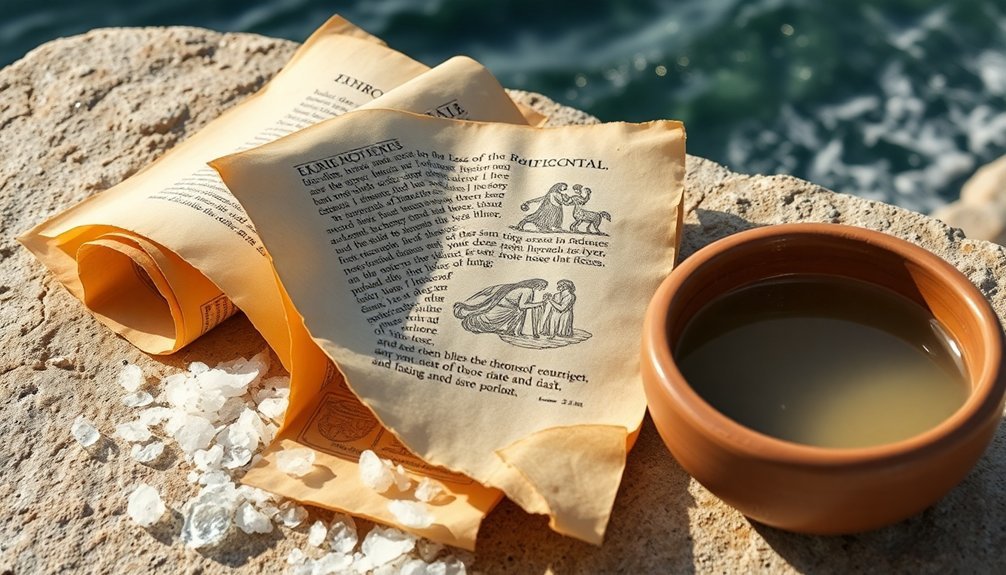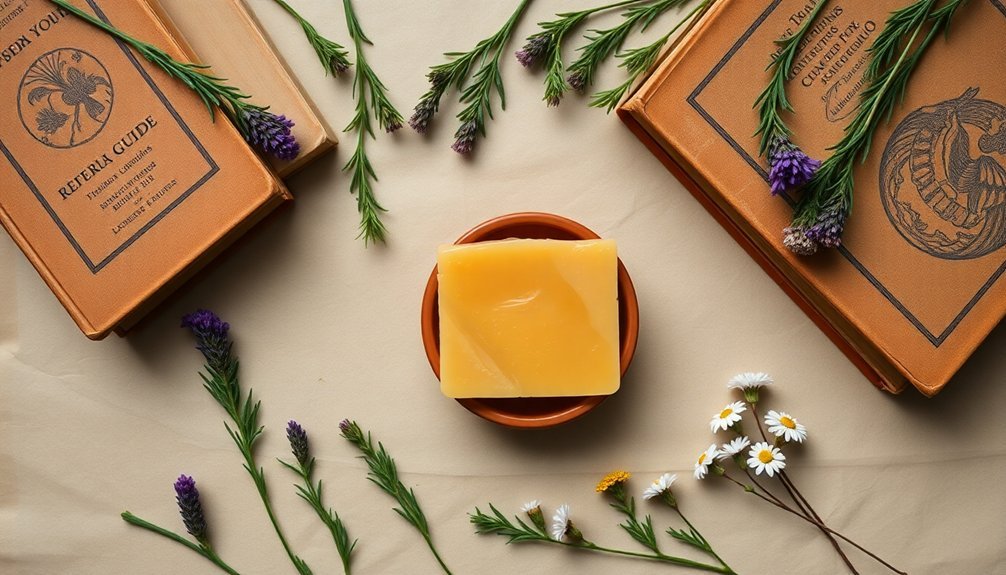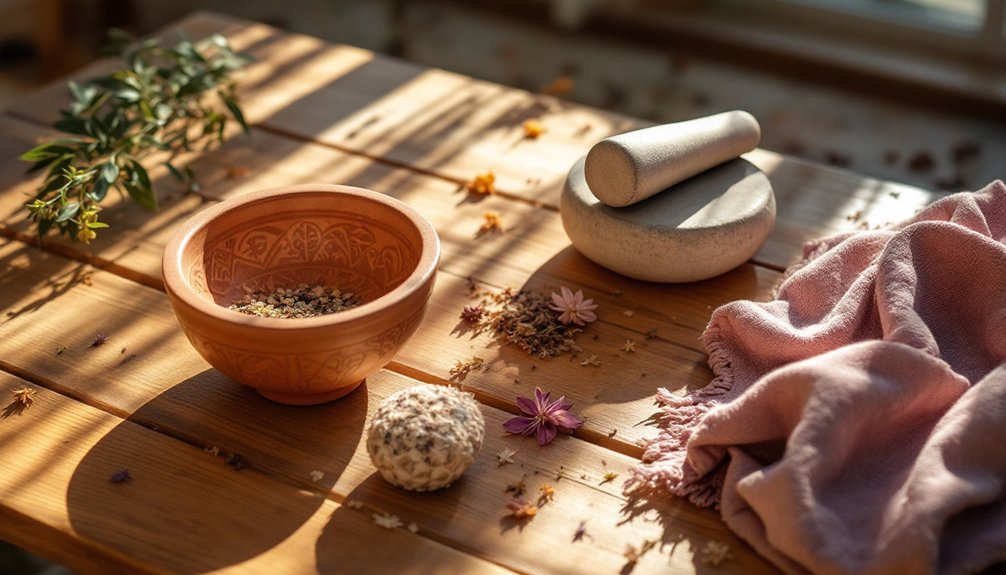Historical texts reveal three primary sources for ancient cleansing methods: Hellenic Purification Texts featuring water and salt rituals, Medieval Soap Crafting Manuscripts documenting tallow and lye techniques, and Herbalist's Cleansing Codices preserving plant-based formulations. You'll find these texts showcase specialized knowledge from various cultures—from Greek miasma-cleansing ceremonies to medieval European soap crafting and regional herbal traditions. These ancient guides continue to influence modern natural skincare approaches with their time-tested wisdom.
Hellenic Purification Texts: Water and Salt Formulations From Ancient Greece

The ancient Greeks understood pollution—miasma—as more than physical uncleanliness; it represented a spiritual stain requiring ritual intervention. They developed elaborate katharmos (purification rituals) to restore harmony and avoid divine retribution.
Miasma haunted Greek life—an invisible stain demanding divine cleansing through sacred ritual to appease the watchful gods.
Water formed the foundation of these cleansing practices, particularly when sourced from natural springs or rivers. You'd enhance its purifying properties by adding salt, creating a potent solution for dispelling negative energies. Before approaching the gods with offerings, you'd need to undergo this cleansing. Many practitioners would also remove their shoes and pin their hair as part of these ceremonial actions to ensure complete spiritual cleansing.
Under the watchful eye of Apollon Katharsios (god of purification) and with Poseidon's power to "shake loose" evils, these rituals weren't merely symbolic—they were crucial spiritual technology.
The Greeks believed miasma could spread contagiously, making regular purification essential for both personal and communal wellbeing.
Medieval Soap Crafting Manuscripts: Forgotten Recipes and Techniques
Crafters combined tallow with lye made from oak ashes, often adding lime, salt, and wheat flour to enhance texture.
They'd clarify lye multiple times for strength before boiling the mixture in large pans until thick enough to mold into cakes.
While primarily accessible to the wealthy, these soap-making methods spread more widely during the 16th century as trade expanded.
Though basic by today's standards, these medieval formulations formed the foundation for modern soap-making practices, bridging ancient wisdom with contemporary cleansing methods.
The detailed instructions found in The Trinity Encyclopedia showcase the sophisticated technical knowledge possessed by medieval craftsmen who carefully documented their soap-making processes.
Herbalist's Cleansing Codex: Historical Documentation of Plant-Based Soap Making

Throughout the annals of human civilization, herbalists have meticulously documented their plant-based cleansing formulas in elaborate codices that reveal sophisticated understanding of botanical properties. These ancient manuscripts, particularly the Aztec Codex, preserved essential knowledge about herbal remedies and soap-making techniques. Many of these traditional remedies align with modern approaches to internal cleansing, focusing on holistic body purification.
You'll find these historical documents fascinating for how they detail customized formulations based on individual skin needs and conditions. Natural oils were infused with specific herbs, creating potent cleansing agents that respected environmental balance.
| Codex Element | Purpose | Cultural Significance |
|---|---|---|
| Herbal Lists | Documented medicinal properties | Preserved biodiversity knowledge |
| Oil Recipes | Detailed base ingredients | Reflected regional resources |
| Infusion Methods | Guaranteed potency | Demonstrated scientific understanding |
| Preservation Techniques | Extended herb longevity | Enabled year-round treatment |
These written records guaranteed these valuable traditions survived, balancing innovation with time-tested wisdom.
Frequently Asked Questions
How Did Ritual Cleansing Tools Differ Across Mediterranean Cultures?
You'll find Greeks and Romans used metal strigils and olive oil, while Etruscans adopted these tools for both genders. Each culture incorporated local herbs, spiritual elements, and natural sponges into their unique cleansing rituals.
What Spiritual Protections Were Embedded in Ancient Cleansing Formulations?
You'll find ancient cleansing formulations contained protective elements like salt to ward off evil, blessed herbs for spiritual shielding, and specific oils believed to create barriers against negative energies and malevolent spirits.
Were Cleansing Rituals Connected to Astronomical or Seasonal Events?
Yes, ancient cleansing rituals were deeply connected to celestial cycles. You'll find many were timed with lunar phases, solstices, and seasonal shifts when communities believed the veil between worlds thinned, enhancing purification effectiveness.
How Did Gender Roles Influence Historical Cleansing Practices?
Gender roles heavily influenced historical cleansing practices. You'll find women were primarily responsible for domestic cleaning, while men handled outdoor tasks. Society judged women's worth by their cleanliness standards more harshly than men's.
What Economic Factors Affected Access to Ancient Cleansing Materials?
Economic factors affecting access to ancient cleansing materials included your social status, trade availability, and resource scarcity. You'd find it easier to afford imported oils and perfumes if you're wealthy or lived near trade routes.
In Summary
You've now journeyed through centuries of cleansing wisdom, from Greece's sacred salt rituals to medieval soap innovations and herbalists' plant-based formulations. These ancient texts aren't just historical curiosities—they're practical guides you can incorporate into your modern routines. By reconnecting with these time-tested methods, you're not only cleaning your body but honoring traditions that have sustained humanity's wellbeing across countless generations.





Leave a Reply